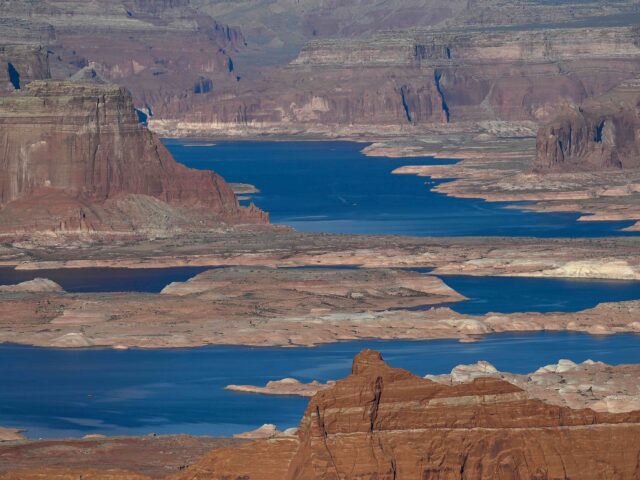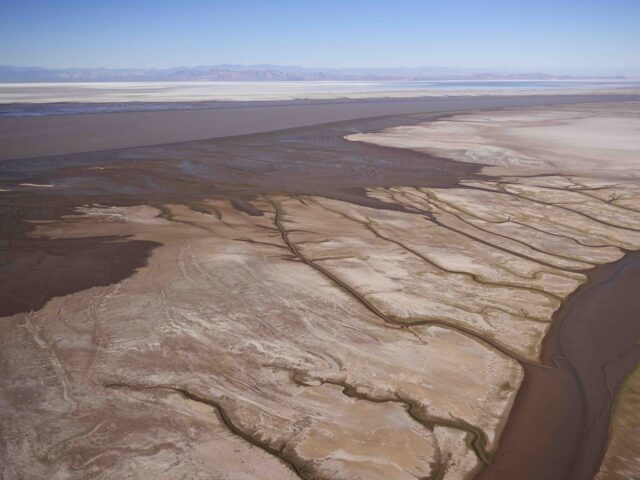A major conflict is brewing between western states that rely on the Colorado River for their water supply, with California holding out against an agreement by six other states to share the burden of drought more equitably.
The context: an ongoing drought amid increasing water use demand that has left many states’ reservoirs at dangerously low levels. Environmentalists blame climate change; whatever the cause, the crisis is real.
As the Los Angeles Times noted Wednesday, the seven states — California, Arizona, Colorado, Nevada, New Mexico, Utah, and Wyoming — missed a Tuesday deadline set by the U.S Bureau of Water Reclamation to agree on cuts to water use. A century ago, the region agreed to the Colorado River Compact, apportioning water between “Upper Basin” and “Lower Basin” states. But increased scarcity has led to calls for a new agreement.

PAGE, AZ – OCTOBER 23: Water from Padre Bay in Utah on flows between a mesa October 23, 2022, which is seen from Page, Arizona. Padre Bay connects with Lake Powell and Lake Powell feeds into the Colorado River, which has been receding due to recent droughts leaving parts of the lake and river parched. The federal government are moving forward with plans to reduce water allocations from the Colorado River Basin to Arizona and is asking millions of residents to reduce their water consumption as the drought get worse. (Photo by Joshua Lott/The Washington Post via Getty Images)
California fears that it has the most to lose in any new agreement, because it has the largest water needs and because it has historically used whatever unused surplus remained after other states drew water from the river. It also generally has senior water rights to those held by users in Arizona, meaning California wants to make Arizona accept cuts to its own water use before California imposes cuts on local farmers and municipalities.
The Times noted:
In a bid to influence federal officials after contentious negotiations reached an impasse, six of the seven states submitted a last-minute proposal outlining possible cuts to help prevent reservoirs from falling to dangerously low levels, presenting a unified front while leaving out California, which uses the single largest share of the river.
Arizona, Colorado, Nevada, New Mexico, Utah and Wyoming called their plan a “consensus-based modeling alternative” that could serve as a framework for negotiating a solution. The U.S. Bureau of Reclamation had set an end-of-January deadline for the seven states to reach a consensus. But California officials opposed making evaporation and other water losses in the river’s Lower Basin part of the calculation, as the change would would translate to bigger supply cuts for the state.
The Washington Post added:
The proposal by the six states — Arizona, Colorado, Nevada, New Mexico, Utah and Wyoming — seeks to protect the major reservoirs in Lake Powell and Lake Mead from falling below critical levels, such as when the dams would no longer be able to generate electricity or at “dead pool,” when water would effectively be blocked from flowing out of these lakes. Before above-average snows in recent weeks, the Bureau of Reclamation was projecting that Lake Powell could start to reach such thresholds by this summer.
…
The proposal lays out potential new cuts for the states of the Southwest that lie downstream from the major reservoirs — Arizona, Nevada and California — as well as the country of Mexico, which has treaty rights to a portion of the river’s water. The proposal would result in about 2 million acre-feet of cuts — the low end of what the federal government has asked for — and would be largest for the biggest consumers of water: California and Arizona. As reservoir levels drop, the document suggests California, which has rights to 4.4 million acre-feet of water, would need to cut more than 1 million acre-feet.
California has offered to reduce just 400,000 acre-feet. An acre-foot is 326,000 gallons, or enough to cover an acre in water one foot deep.
California officials say they are preparing an alternative plan to submit to the federal government.
Another factor looms: Mexico, where the Colorado River used to flow into the Gulf of California, has shown some interest in restoring the river. Today, it simply ends in the desert.

COLORADO RIVER DELTA, BAJA CALIFORNIA – OCTOBER 24: Drought, overconsumption, and climate change, are main factors dissipating the amount of Colorado River water that will reach the Sea of Cortez on its journey through the Colorado River Delta on October 24, 2022 in Baja California, Mexico. The flight for aerial photography was provided by LightHawk. (Photo by RJ Sangosti/MediaNews Group/The Denver Post via Getty Images)
Conservationists argue that the flow needs to be restored so that at least some part of the Colorado River reaches the Sea of Cortez, as it once did.
Joel B. Pollak is Senior Editor-at-Large at Breitbart News and the host of Breitbart News Sunday on Sirius XM Patriot on Sunday evenings from 7 p.m. to 10 p.m. ET (4 p.m. to 7 p.m. PT). He is the author of the new biography, Rhoda: ‘Comrade Kadalie, You Are Out of Order’. He is also the author of the recent e-book, Neither Free nor Fair: The 2020 U.S. Presidential Election. He is a winner of the 2018 Robert Novak Journalism Alumni Fellowship. Follow him on Twitter at @joelpollak.

COMMENTS
Please let us know if you're having issues with commenting.